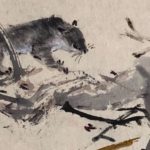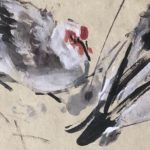Chen Wen Hsi (b. 1906) is among the most influential pioneer artists in Singapore’s history. Regarded as a first-generation artist, Chen was in the forefront of the Chinese avant-garde movement in Singapore during the 1950s. He was a member of a group of five prominent artists that founded the Nanyang style, a landmark in the art history of Southeast Asia.
A highly esteemed painter and art educator, Chen’s works have significantly shaped decades of creative development in the art community even prior to the establishment of Singapore as a sovereign nation. His endless inventiveness and creative excellence in Chinese painting have commanded the respect of the Chinese and the international art world.
Background
Born in 1906
Baigong, Guangdong Province, China
Chen Wen Hsi moved to Singapore where he lived until his death in 17 Dec 1991.
Style
Chen was proficient in both traditional Chinese Ink and Westernoil painting , and experimented with a variety of styles ranging from Fauvism and Cubism. In Chen’s exhibition held in May 1956, Sullivan noted his fascination for man-made things and clutter. The artist loved to experiment with the interplay of light and forms in chaotic subjects, like a junkyard. His unique style which showed interest in angles but not Cubist; strays not far from reality and is obsessed with shapes, and yet not an abstract painter. Chen also did not take to modern western art philosophies of that by western counterparts of his time like Picasso and Salvador Dali
Chen was also interested in human figures. He also did not see that humans are complex with distortions and conflicts, but merely a pattern of images, yet not like a pieced jigsaw puzzle. His interest was especially in local Indian people, particularly blue-collared workers and dairymen working in cattleyard; the geometric forms of Indian women dancers was an ideal subject of study for the artist
Chen’s mastery in depicting human figures was also found in keen observation of nature and animals His subjects include landscapes , figure, birds and animals, still life studies andabstract compositions.
Chen was especially adept at drawing egrets and monkeys. Among all the animal paintings by him, Chen’s gibbon paintings stand out, as they were noted by Chen’s attention to detail and sensitive rendering of the beautiful creatures.His first inspiration from painting gibbons came from a reproduction of a gibbon painting that formed the right triptych of the famous painting, White Robed Guanyin, Crane and Gibbon by the 13th century Southern Song Dynasty Chinese artist Mu Xi (牧溪).
Awed by its lifelike quality, he was convinced with Mu Xi’s great skill in close observation of the gibbons. So day and night, Chen studied Mu Xi’s print and emulated the painting. Chen had never seen a gibbon when he was in China, and as a result he did not realize that gibbons, unlike monkeys, had no tails!
It was only much later in the late-1940s, that a foreigner pointed out his error in his painting, and corrected him. At around then, he had bought a white faced gibbon for $300 at a local pet shop shortly after he arrived in Singapore. This gave him immense opportunities to study the creature’s postures and its characteristics, by rearing it in his home garden. In time, Chen had a total of six pet gibbons – one white, one grey and four black ones.
Honours
For his contributions to the fine arts in Singapore, Presiden Yusok Ishak conferred Chen the Public Service Star in 1964.
In 1975, the National University of Singapore conferred Chen an honorary doctorate, and Chen became the first local artist to be given the honour.
Chen was also awarded the Golden Chapter by the Taiwan National Museum in 1980, and the first ASEAN Cultural and Communication Award in 1987.
After his death in Dec 1991, Chen was awarded a posthumous Meritorious Service Medal
Awards
1964 Public Service Star
1975 Honorary degree of Doctor of Letters, National University of Singapore (NUS)
1980 Gold Medal, The National Museum of History, Taipei, Taiwan
1987 The First ASEAN Cultural Ad Communication Award
1992 Meritious Public Service Award ( Posthumous)


